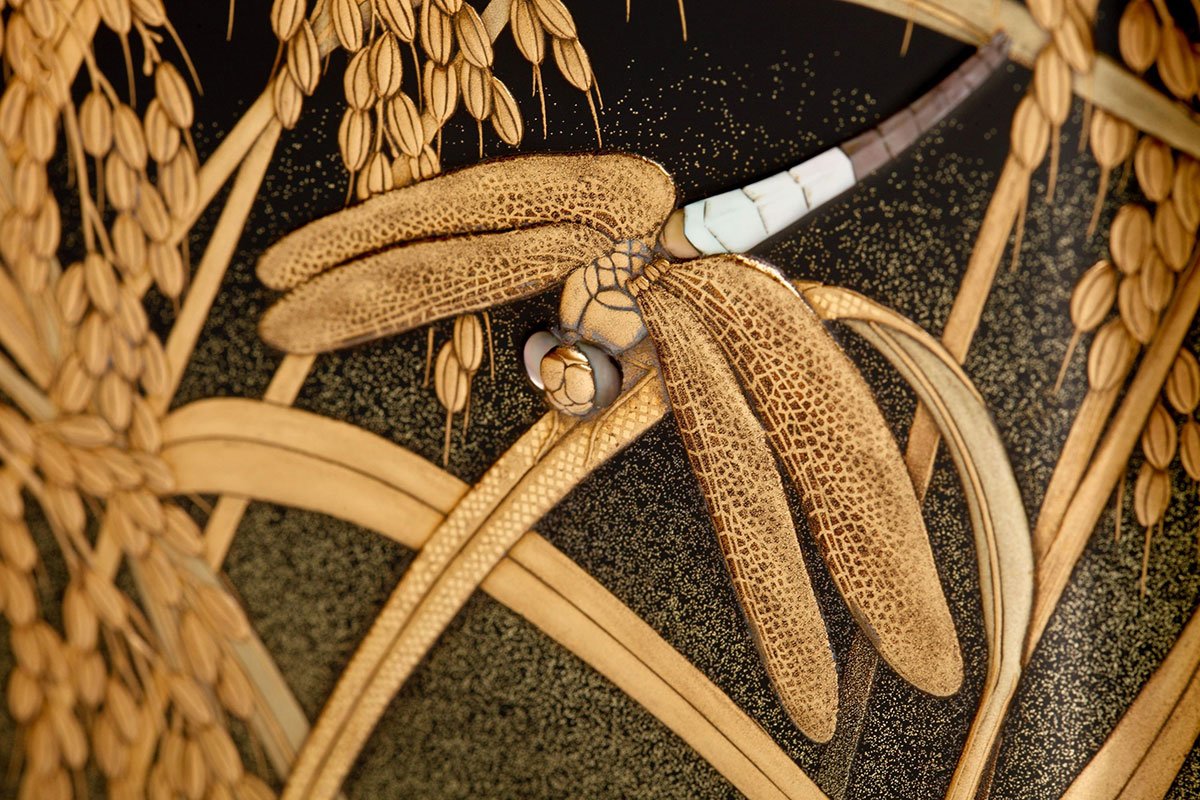MEIJI-TAISHO
NISHIMURA ZOHIKO VIII, DRAGONFLY & RICE TEBAKO
Tebako or ornamental cosmetic box in a rectangular form with softly rounded edges and indented corners, decorated with bending stalks of ripening rice and twenty jeweled dragonflies playing over the top and sides. Of roiro or mirror-polished black lacquer decorated in gold and silver taka-maki-e or raised lacquers, kirikane or cut and inlaid gold lacquers, and extensive nashiji or gold flake and gold dust lacquers and aogai or inlaid mother-of-pearl. With applied silver mounts. Attributed to Nishimura Zohiko VIII (the go or art name of Nishimura Hikobei, 1887 – 1965). Taisho era, circa 1912 – 1920.
With the original, period storage box, inscribed on the exterior of the lid: Inaho Katsumushi On-tebako or Ripening Rice (and) Dragonfly Honorable Cosmetic Box.
The Zohiko lineage of lacquer artists has worked in Kyoto from 1719 to the present. Nishimura Zohiko VIII was the 8th generation family head, and acceded to the family title when he came of age in 1910, taking over from his uncle, Zohiko VII, who retired to become an independent artist. Zohiko VIII founded a school for maki-e lacquer in Kyoto, and was active in the promotion of lacquer arts.
During the late Meiji and Taisho eras the Zohiko artists created lacquers for the Imperial Household Agency, princely families, and for the Mitsui and Sumitomo commercial and banking families. Depending on the client and the occasion, the quality of these works might range from the good to the unbelievable. This tebako represents their finest level of work, and was unsigned as an imperial commission (the original green storage box cords used by the Imperial Household Agency frayed and have been replaced, though the originals remain folded inside the storage box).
For another example of Zohiko VIII’s work, c.f. Kagedo’s catalogue Yukei, number 71; see also Kagedo’s catalogue Arts of Imperial Japan, number 30.
Dragonflies symbolized the brave, short-lived ideal of the samurai for the Japanese. Here glowing, jewel-like they hover and flit over rice just before the autumn harvest. As rice reflects the purity of Shinto, so the dragonflies bring to mind bravery, honor, youth. The transience of life pales before its beauty. Zohiko VIII matched these ideals with peerless craftsmanship that transforms the individual materials of sumi charcoal, lacquer sap, metal powders and pieces of shell, made them breathe in a medium of glistening gold and black, shimmering shell inlays and wonder.
Nishimura Zohiko VIII, Dragonfly & Rice Tebako
Artist Name: Nishimura Zohiko VIII
Period: Meiji Taisho
Mediums: Lacquer
Form: Ornamental Boxes
Origin Country: Japan
5 1/8” high x 7 ¾” wide x 9 ½” long
This piece is no longer available.







